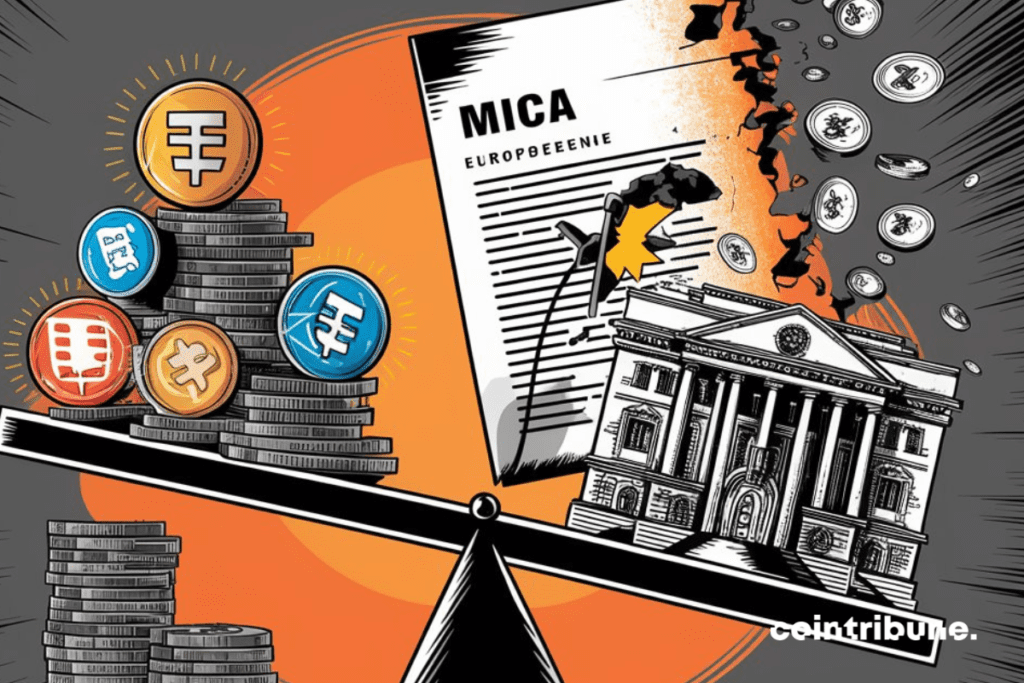Sun 11 Aug 2024 ▪
3
min read ▪ by
Europe is positioning itself as a world leader in cryptocurrency regulation, with the recent adoption of the MiCA regulation. However, behind this ambitious project lies a worrying paradox: this legislative framework, supposed to stabilize the market, could in reality weaken the very foundations of the banking system. This is the warning issued by Paolo Ardoino, CEO of Tether, who sees these new rules as a threat not only to stablecoin issuers but also to all European financial institutions.

Tether CEO’s Concerns: Imminent Systemic Risk
Tether CEO Paolo Ardoino has expressed serious concerns about the potential repercussions of the MiCA regulation, recently adopted by the European Union. In an exclusive interview, he stressed that far from strengthening the security of the cryptocurrency market, this legislation could actually exacerbate the vulnerabilities of the banking system. According to Ardoino, the requirement for stablecoin issuers to hold 60% of their reserves in European banks creates a major risk. He points out that these financial institutions, operating on a fractional reserve system, are inherently exposed to the risks of bank runs, a danger amplified by the requirements imposed by MiCA.
Ardoino also highlighted a critical regulatory gap: the European Union’s $100,000 deposit guarantee limit. For players of Tether’s size, this protection is trivial and could prove catastrophic in a crisis.
A Warning: The Case of Silicon Valley Bank
Paolo Ardoino points to real-world events, including the collapse of Silicon Valley Bank in 2023, to illustrate the real dangers that this new legislation could bring. The failure of this bank, which held large reserves of USD Coin, not only triggered a bank run, but also led to a de-pegging of the stablecoin, sending shockwaves through the entire cryptocurrency market. Ardoino warns that cryptocurrency market regulation could replicate this scenario in Europe, as it imposes conditions on stablecoin issuers that directly expose them to the fragilities of the banking system.
For Ardoino, the situation is clear: by forcing stablecoins to rely more on European banking institutions, MiCA could create a similar, if not more destructive, cycle in the event of a European bank failure. According to him, the regulation of the cryptocurrency market, while motivated by a laudable intention, does not sufficiently take into account the lessons learned from recent financial crises, thus exposing the European financial system to unprecedented potential risks.
Before going further, it is imperative that European regulators reassess the implications of these new rules to ensure that they effectively strengthen the resilience of the financial system, rather than increasing its fragility.
Maximize your Cointribune experience with our “Read to Earn” program! For each article read, earn points and access exclusive rewards. Sign up now and start enjoying benefits.
Join the “Read to Win” program
A graduate of Sciences Po Toulouse and holder of a blockchain consultant certification issued by Alyra, I joined the Cointribune adventure in 2019. Convinced of the potential of blockchain to transform many sectors of the economy, I made a commitment to raise awareness and inform the general public about this constantly evolving ecosystem. My goal is to enable everyone to better understand blockchain and seize the opportunities it offers. I strive every day to provide an objective analysis of current events, decipher market trends, relay the latest technological innovations and put into perspective the economic and societal challenges of this ongoing revolution.
DISCLAIMER
The views, thoughts and opinions expressed in this article are solely those of the author and should not be considered investment advice. Do your own research before making any investment decision.




